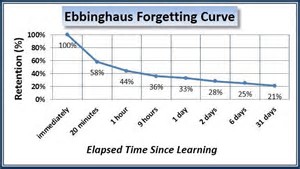We have all heard this phrase before. But do you realise its significance in the impact of any learning and development training programs?
Ever been to see an amazing comedians live?
For 90 minutes they reel off joke after joke and funny stories and you laugh your head off. Yet when you get to the office the next day and someone asks you “How was the show last night?” you say “Fantastic, what a laugh, he told this joke about…….” and you can’t remember it.

Similarly think about when you have taken part in a training event in your workplace with a motivational speaker. You listen to the motivational stories and the how that person over come so many challenges and you begin to believe you can do the same. You are standing up high fiving your neighbour next to you. You leave inspired with a workbook full of life changing tips and ideas and you are about to set the world on fire.

The next day your colleague asks you about the training and you tell them “It was great, there was this amazing tip about…..” and once more you have forgotten what at the time was so motivating.
How does this happen?
You can thank Dr Hermann Ebbinghaus the German Psychologist and his Forgetting Curve from 1885.

The decline of memory retention in time. This curve shows how information is lost over time when there is no attempt to retain it. Just 44% retention after 1 hour and only 33% retention after 1 day. A typical graph of the forgetting curve shows that we tend to dramatically reduce our memory of newly learned knowledge in a matter of days or weeks unless we consciously review the learned material.
Do not panic! For our brains forgetting is a normal natural process. If you learn a new technique or information and it is not used soon after your brain purges that new information. Not surprising when you think about all the stimulae your brain receives every minute of the day. Dr Henry Roediger, an educational phycologist, realised this when he found that if you use this new information soon after learning it your brain deems it important and remembers it. He says its like your brian metatags the information into the brain for easier retrieval.
What can we do to improve the situation?
Simple really, change your thinking around learning. Practise, practise , practise and remember to use it or lose it!
In a recent article for Zaraffa’s GRIND magazine Peter Baines and I were interviewed about bringing about real change in audiences. In it I explained that my passion and focus is on giving people simple proven internal tools for performance improvement.
By providing techniques that people can use themselves they discover, then learn, then practise during training so that when they leave the new tool is already internalised and tagged as important by the brain hence better recall. This is exactly the process that Dr Roediger explains delivering the opportunity for the learner to think about, process and interact with the new material during and in the days after the training.

 Read full article here
Read full article here
So its true, when it comes to delivering long lasting change in your workforce you need to give them the opportunity to think deeply and practise with the new information or techniques during the training. Then participants will leave the training knowing that the new tools they learned work because they have practised them for themselves. People can use these practised take away tools and apply them in the workplace for improved performance. Confidently using them to make the desired lasting changes personally and professionally in the organisation.
Improve the impact of your Learning and Development training by using a “use it or lose it” style of learning.
If you are interested in learning more about MindStores unique tools for performance improvement and our use it or lose it style of training for your organisation then get in touch here today


